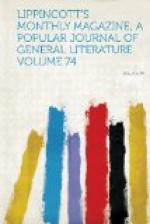This is a very fair sample of the convents of the stricter and cloistered orders: there are some exceptional houses, such as that of the Sepolte Vive, where the rule is far more austere. There is but one convent of this description in Rome, and I believe one or two in France. It is a noteworthy fact that most of the strictest observances of penance originated in France, and are continued there to this day. This convent of the Sepolte Vive ("Buried Alive”) is not formally sanctioned by the papal authority, but only tolerated. The nuns were forbidden more than ten years ago to admit any more novices, and although the individual zeal of those who started the order was not exactly censured, still a tacit intimation of its being considered excessive and imprudent was given by the highest ecclesiastical court. Among their customs (which much resemble those of the Trappist monks) these nuns have that of digging their own graves, and as the cemetery is small and included in the “enclosure,” the oldest graves are opened after a period of forty or fifty years, and the crumbling contents ejected to make room for the lately deceased. The death of a nun’s nearest relation, be it father, mother, brother or sister, is made known to the superior alone, and she in her turn announces it, not to the bereaved one, but to the whole sisterhood, in this manner: They are all assembled in the community-room, and admonished to “pray for the soul of the father or mother” (as the case may be) “of one among their number.” To the day of her death the nun never knows how near and dear by the ties of Nature may have been the soul for which she has prayed every day since the announcement was made.
The Sepolte Vive, when found guilty of any breach of the rule, are labeled with a ticket attached to their habit, and on which their fault is written in large, conspicuous letters—for instance, “Disobedience,” “Curiosity,” “Talkativeness”—and this they wear at their ordinary avocations for as many hours as the superioress commands. They never undress on going to bed, and wear the same habit winter and summer, the stuff being too hot for the one and too cold for the other; so that at all times the penance is the same. On the wrists many of them wear iron manacles that graze the skin and cause constant irritation at every turn of the hand: this is sometimes imposed as a penance, but very often is voluntarily inflicted on themselves by zealous members of the sisterhood. Before the prohibition to receive additional novices the sisterhood consisted of a fixed number, and when a vacancy occurred by the death of one the place was filled by the first on the list of postulants. This list was always a large one, and generally contained many names belonging to the noblest families of Rome. These details were gathered from the same lady who acted as madrina to the Dominican nun Sister Maria Colomba; and when she and a friend obtained permission from




